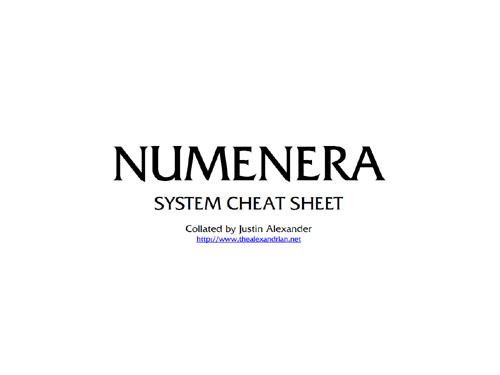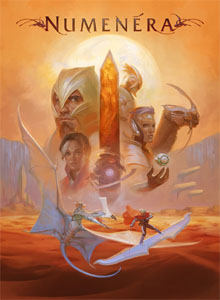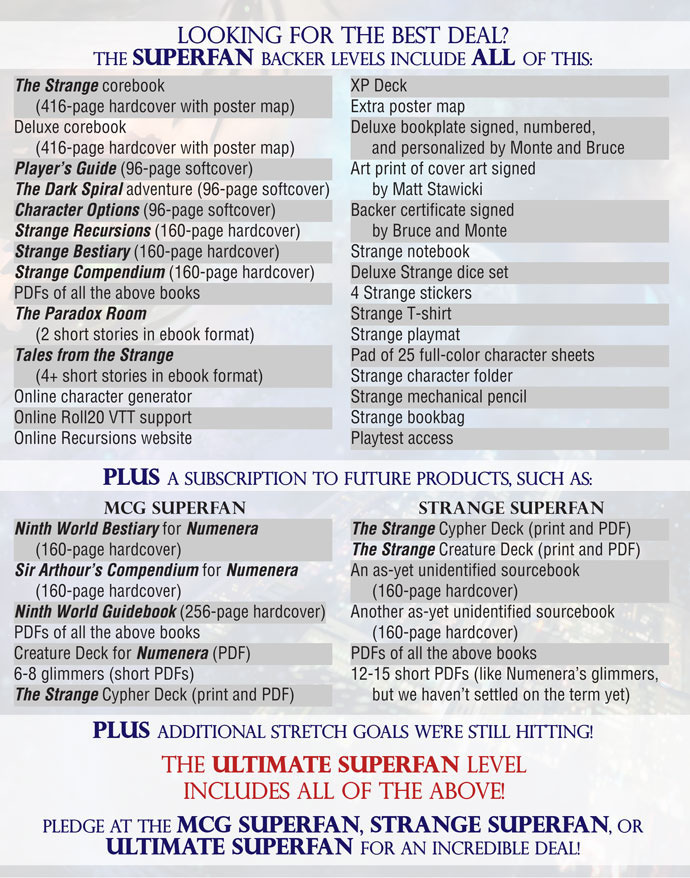A couple months ago I posted a draft version of my system cheat sheet for Numenera. At the time, I predicted that I would be running the game sooner rather than later. That turned out to be really, really true. I’m now running the game regularly for three groups:
- The original playtest group I organized.
- A second group which had gathered at my house for random gaming and asked me if I had a roleplaying game ready to roll.
- A group composed entirely of players new to roleplaying games.
It’s been a rousing success with all three and I’ve now run a total of 12 sessions. At least one of these groups will be winding down once the original adventure is completed (Vortex), but one of the groups has already transitioned to a full campaign using The Devil’s Spine as a foundation and the group of newcomers also appear to be interested in the long haul (although I think they’ll end up going a different direction).
In any case, I’ve used my play experience to both expand and refine the cheat sheet, which I now consider to be in its final version. As before, this cheat sheet is designed to summarize all the rules for the game — from basic action resolution to advanced combat options. I’ve found that it’s a great way to get a grip on a new system and, of course, it’s also a valuable resource at the game table for both the GM and the players. (For more information on the methods I use for prepping these sheets, click here.)
IT’S STILL A GM SCREEN!
The cheat sheet still uses landscape formatting suitable for insertion into a modular, four-panel, landscape-oriented GM screen. (Just like the one backers of the Numenera kickstarter were able to buy as an add-on. And which you can buy here.) I’m not including graphics for the front of the screen, but if you buy the Numenera GM Screen PDF you’ll be totally golden.
You may notice, however, that the final version of the sheet has more than four pages. What I’ve been doing is printing the “Miscellaneous Rules” and “Numenera” pages using inverted duplex printing and then taping that sheet to the “Hazards & Combat Modifiers” page. Insert the “Hazards & Combat Modifiers” page into the screen and you’ll be able to fold the other sheet over so that it displays the “Miscellaneous Rules” page, but can be flipped up to show the other two pages.
(Alternatively, of course, you can just choose two pages not to include.)
WHAT’S NOT INCLUDED
These cheat sheets are not designed to be a quick start packet: They’re designed to be a comprehensive reference for someone who has read the rulebook and will probably prove woefully inadequate if you try to learn the game from them. (On the other hand, they can definitely assist experienced players who are teaching the game to new players.)
The cheat sheets also don’t include what I refer to as “character option chunks” (for reasons discussed here). So you won’t find types, descriptors, or focuses here.
You also won’t find most of the optional rules for the game. I may add those later, but not yet. (The exception are the rules for modifying abilities; I suspect they’re going to be too useful not to have handy.)
HOW I USE THEM
I generally keep a copy of my system cheat sheets behind my GM screen for quick reference and I also place a half dozen copies in the center of the table for the players to grab as needed. The information included is meant to be as comprehensive as possible; although rulebooks are also available, my goal is to minimize the amount of time people spend referencing the rulebook: Finding something in 6 pages of cheat sheet is a much faster process than paging through a 400 page rulebook. And, once you’ve found it, processing the streamlined information on the cheat sheet will (hopefully) also be quicker.
The organization of information onto each page of the cheat sheet should, hopefully, be fairly intuitive. The actual sequencing of pages is mostly arbitrary.
Page 1: For Numenera, the difficulty terrible is the heart of everything. Once you understand that, the special rolls, GM intrusion, and the concept of advantage/disadvantage 90% of the rest of the system actually becomes irrelevant. This page is likely to become superfluous quickly. You’ll note that I included examples of GM intrusion: This is unusual for my cheat sheets, but so much of Numenera is designed to empower strong, flexible rulings by the GM that providing this kind of idea fodder feels right to me and has proven useful during play.
Page 2: The core of the combat mechanics. If you’re teaching new players the game, you really only need to walk them through these first two pages. (I’ve been adding another column or so of additional material at the beginning of each subsequent section, slowly adding more tools to the players’ toolboxes.)
Page 3: The extended combat actions and options. The rules for “Trading Damage for Effect” are technically an optional rule, but I’ve found them too invaluable not to include here. (Compared to the draft version of the sheet, you may also notice that I’ve pulled out the guidelines for simplifying multiple enemies and the boss package you can use to buff NPCs. Very useful stuff for the GM that’s buried deep in the rulebook.)
Page 4: A collection of miscellanea. Optional rules are off on the right, but I haven’t used them yet in my own game. (You’ll also note a couple of house rules tucked down in the corner. These are still being playtested, but I think they’re useful.)
Page 5: Everything that you need to know about the numenera. This stuff is highly situational, but one concept I’ve found needs to be stressed to new players is the idea of scavenging for numenera. This process appears to be non-intuitive so you need to let them know it’s an expected part of the game world.
Page 6: Hazards & Combat modifiers. I expressed bafflement when I posted my draft version of the sheet for why all of these modifiers exist. In actual practice, I’ve found them more useful than I anticipated.
PLAY NUMENERA
As I mentioned before: Y’all should grab a copy of Numenera and start playing ASAP. It had my official “I Had a Ton of Fun Playing That” seal of approval and twelve more sessions has only served to add a “I Had a Ton of Fun Running That” merit badge.
FURTHER READING
The Art of GM Intrusions
Numenera: Calibrating Your Expectations
Numenera: Last Precept of the Seventh Mask
Tales from the Table: Last Precept of the Seventh Mask
The Numenera Tavern
Numenera: The Wandering Walk
The Moon of Numenera
Numenera: NPC Allies
Numenera: Grappling
Numenera: Attacking Objects
Numenera: Identifying Numenera
Numenera: Into the Violet Vale – Prep Notes
Review: Weird Discoveries
The Aldeia Approach
Numenera: Welcome to the Ninth World
(Please note that the title page has been altered to remove the copyright logo graphic I originally used in the draft version. All Numenera content on this website is issued under the fair use doctrine and it should be explicitly understood that no content on this website is issued under the MCG fan use policy.)
















